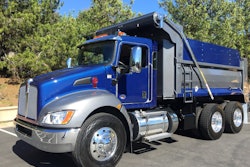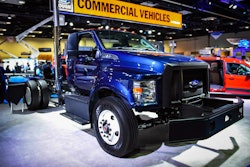UPDATE: A previous version of this article said the development team behind the Canter E-Cell is developing a PTO for the truck in Atlanta, Ga. However, the team is actually developing an electric version of the PTO in Kawasaki, Japan. The article has been updated to reflect that and we regret the error.
Mitsubishi Fuso has been testing its Canter E-Cell work truck in Europe since 2014. But at the Work Truck Show in Indianapolis Wedensday, the all-electric truck, which is still in development, made its U.S. debut.
As it’s currently spec’d, this truck’s usefulness is mainly limited to urban pickup and delivery. But as we found out in a conversation with Fuso engineer Chris Burdett, the company’s ambitions for the Canter E-Cell’s production run, slated for 2017, extend into construction applications as well.
 The Canter E-Cell’s battery packs are suspended from either side of the truck’s frame.
The Canter E-Cell’s battery packs are suspended from either side of the truck’s frame.The truck is powered by four 390-volt, 48.8 kWh lithium-ion batteries. The batteries are encased and suspended from the frame on both sides of the truck. Because the truck uses the same cab and frame as Fuso’s FE series trucks, the company’s engineers had to slightly modify and widen that FE frame to accommodate these battery packs, Burdett says.
In terms of power, the batteries and the 110kW AC motor provide 150 horsepower and 479 lb.-ft. of torque at startup. The truck currently only has a gross vehicle weight rating of 13,230 lbs. and a payload capacity of 6,470 pounds.
Burdett says that in testing the truck has consistently achieved a range of more than 60 miles with a payload of 4,400 pounds before needing to be recharged. Some of that range is thanks to the truck’s ability to recharge the batteries a bit each time the accelerator is released, a feature found on many current hybrid vehicles.
When the time does come to plug the Canter E-Cell in, there are two ways you can go about it. The first is a standard 230-volt, 30 amp charger that takes seven hours to replenish the batteries.
The second is a proprietary 290 volt, 100 amp CHAdeMO quick charger which can fully recharge the truck in under an hour.
Testing
Fuso engineers were able to gather a year’s worth of data generated by fleets in Portugal who tested eight pre-production models by incorporating them into their workflow.
Based on diesel fuel pricing and electricity costs where the truck’s were operated, the E-Cell truck’s saved their operators 64 percent over the cost of operation of a diesel Canter.
Burdett says that during that testing the majority of the operators were able to get a full day’s cycle between charges in an urban delivery and pickup application.
But Fuso sees this truck as the future. As such it’s engineers would love to see it outfitted with a dump body. In Kawasaki, Japan at Fuso’s Global Hybrid Center, engineers are developing an electrified PTO that would differ from the mechanical/hydraulic PTOs used with conventional diesel truck transmissions, said Fuso spokesman Ted Arnold.
Burdett said, adding “it wouldn’t be much of a work truck,” without the ability to support a dump body and perform more demanding applications.
The company plans on touring the Canter E-Cell around the U.S. in the hopes of garnering a bit of feedback from customers in this market.
Fuso plans to release the Canter E-Cell in Japan in 2017 with a launch in North America following shortly after.













